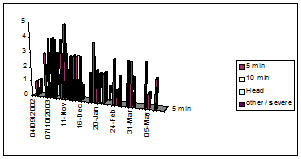BACKGROUND
RESEARCH
An
initial project was carried out at Westcroft School and
Sports College Wolverhampton England in 1999 - 2000.
44
children from Key stages 1 - 4 were selected and each
child was interviewed and observed and consultation
questionnaires were carried out with parents /
teachers / support professionals. 22 were given the
therapies and the remaining 22 were not
given any thherapy support. Goals (
objectives ) were set
individually for each child in agreement with parents
and staff
BY
THE END OF THE ACADEMIC YEAR
we achieved
84% of our
aims with thERAPY group of children.
THIS IS COMPARED TO ONLY 16%
OF OBJECTIVES BEING MET WITH THE NON- THERAPy GROUP.
the
next stage:
With
funding from 'The Behaviour Improvement Programme' the
HET programme grew throughout schools and other
organisations in Wolverhampton. Based at a Primary
Pupil Referral Unit in Wolverhampton, we were able to
build upon the findings from our research, refine the
research methods and further develop the good
practice identified from the pilot programme.
-
The
practice of entry and exit consultation
questionnaires was maintained. Every year we have
consistently scored in excess of 85% of our
'Objectives Met' target.
-
Other
methods of evaluating our successes have been
implemented.
-
The
scope of the therapies has been expanded.
-
The
support to parents / carers and families has been
developed and expanded.
-
A
nationally recognised and accredited training
programme has been established in HET with a
continuous professional development programme in
place
-
An
Local Authority based referral service is offered from here.
-
Qualified
HETs are now in post, in various multi-agencies
across the Authority.
-
New
research is taking place into other HET approaches.
This is in partnership with other agencies across
the city, which aims to support children with
emotional and behavioural problems.
Over
the past 9 year our research has led to other methods of
demonstrating how effective HET is. This has been so
important in embedding the HET philosophy within various
organisations amd we have had to prove how effectiv HET
is to the children and the famiies every step of the
way.
The
following methods ae examples of the proof of HET and
each practitoner has to demonstrate this as part of
their training.
Below
are some examples of how we go about this:
Measuring
the effectiveness of what we do.
Consultation
questionnaires with children, parents / staff and other
support professionals. These include quantitiative and
qualititative data collection
Child
observations in home and school
settings.
Behavioural
profiles.
Therapy
treatment and review sheets
Tracking
behaviour incident logs and analysing data in
correlation to therapeutic intervention / changes in
therapy treatments etc.
 |
This graph shows consequences of
undesirable behaviours. These vary from 5 or 10
mins out or visit to Head Teacher or hone call
home. These drop when the child is on the
programme. |

